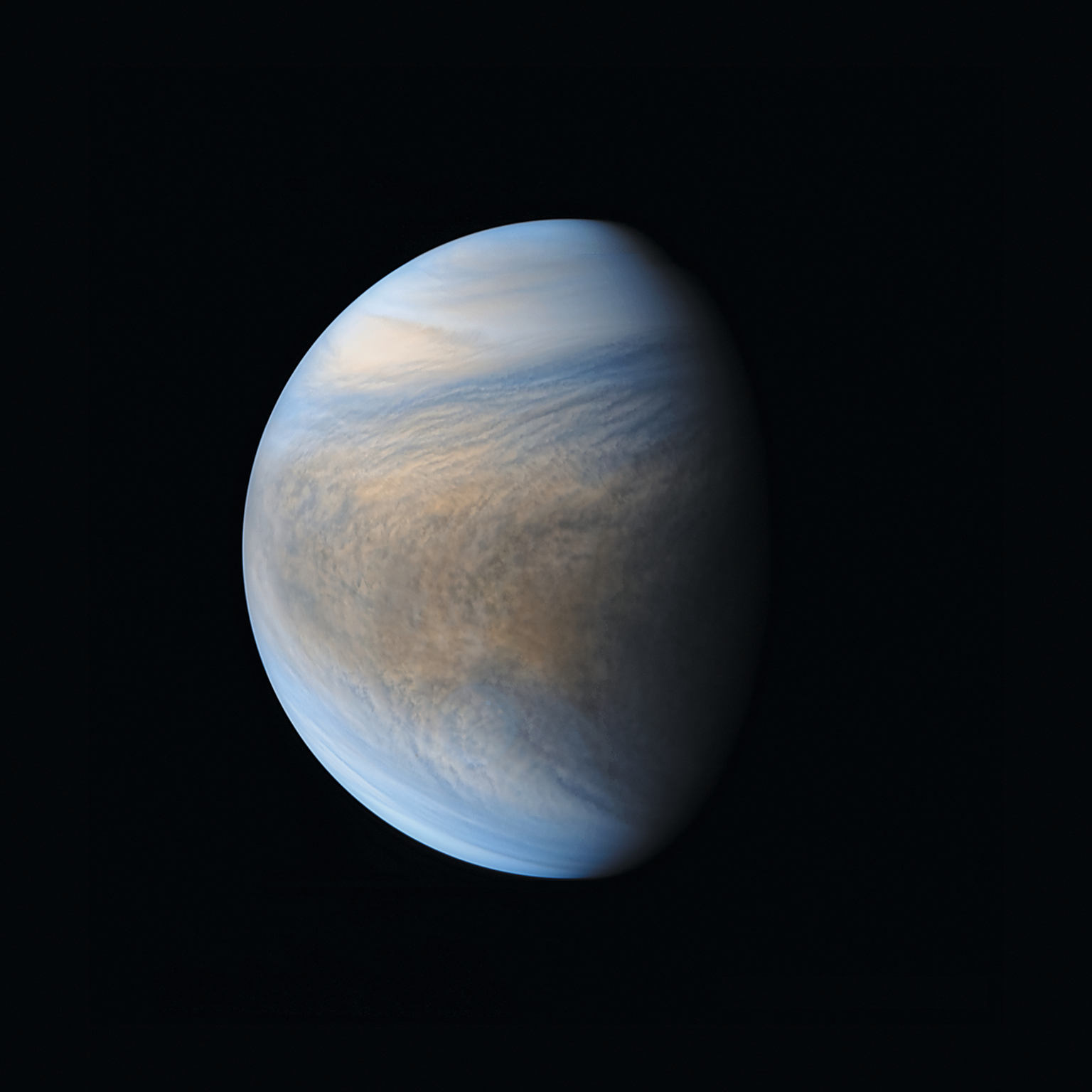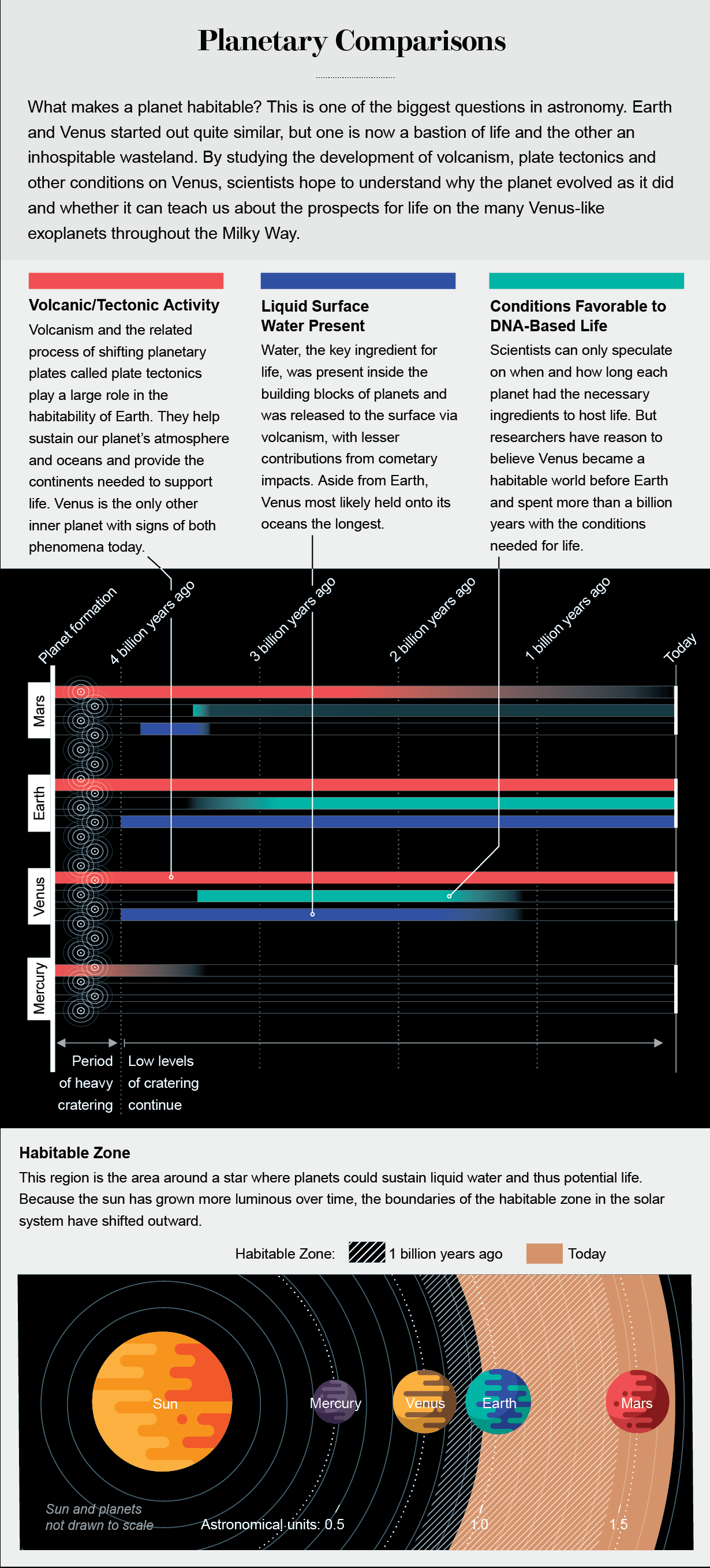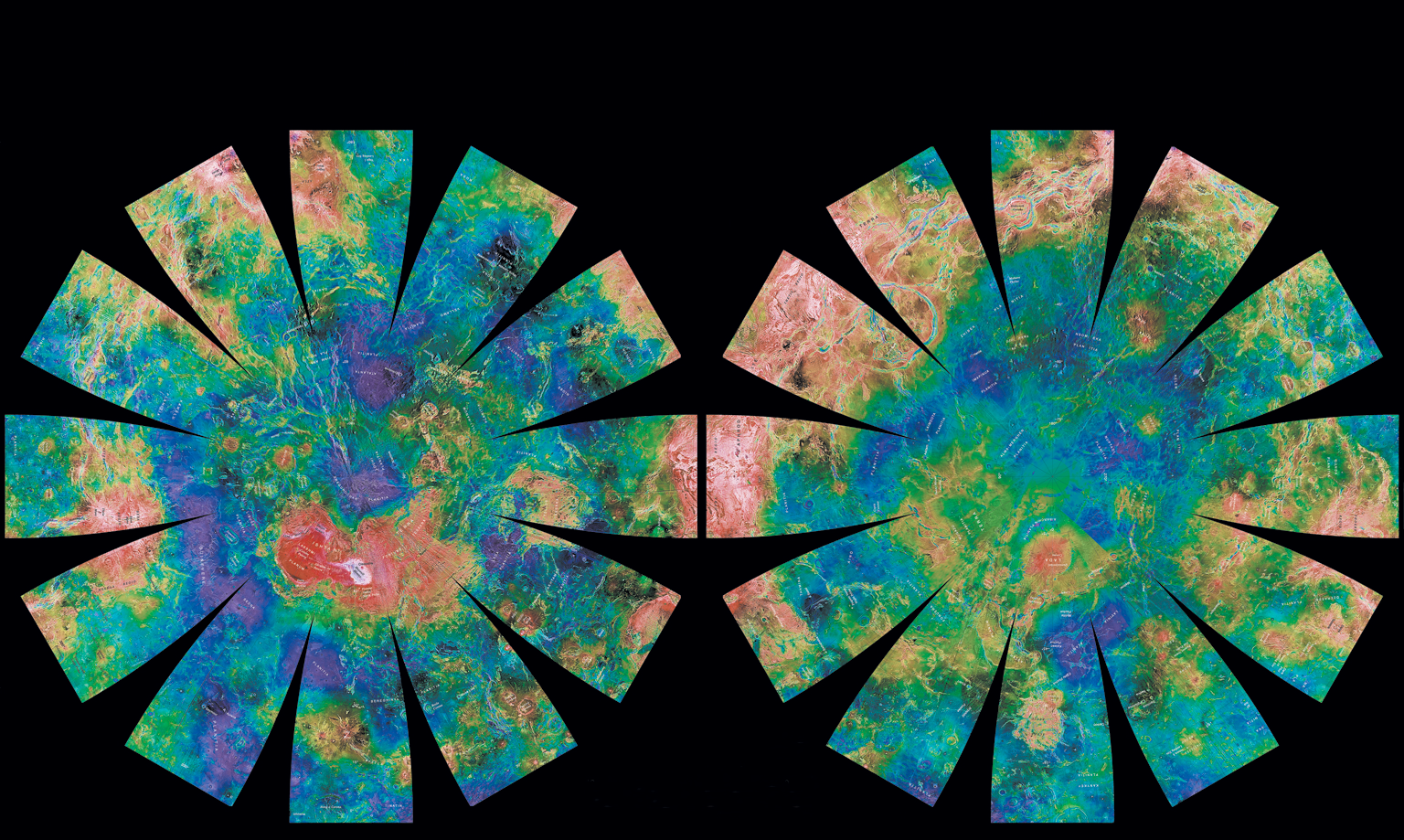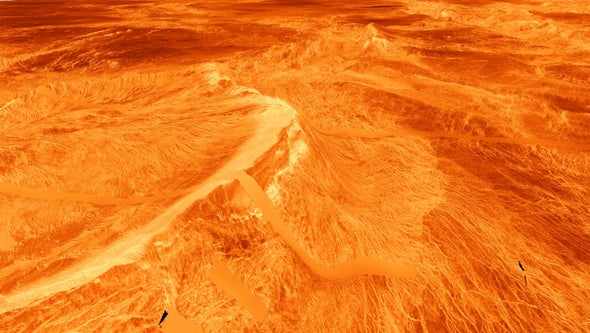In 1982 all anyone could talk about in the planetary science department at the Massachusetts Institute of Technology was the cancellation of NASA’s latest flagship mission, the Venus Orbital Imaging Radar (VOIR). One of us (Dyar) was a graduate student there at the time. (The other two were still in college and elementary school.) Graduate students wept openly in the hallways, and veteran faculty shook their heads. The newly elected Reagan administration had enacted sweeping cuts to space exploration, and VOIR was one of the casualties.
Shortly afterward, though, scientists cobbled together plans for a bargain-priced spacecraft ($680 million) made of leftover hardware and, miraculously, saved the mission. In 1989 the Magellan orbiter launched on a reconnaissance mission to Venus, and by 1990 it was in orbit. Over the next five years the orbiter returned near-global radar images, gravity data and a topographic map of the second planet from the sun. It was the latest in a long line of Soviet and U.S. missions to our neighboring planet, but when Magellan plunged to Venus’s surface in 1994, NASA’s support for Venus spacecraft died with it. Since then, scientists have submitted more than 25 proposals for return missions to Venus, and although some of those received high rankings from review boards, none were approved until very recently. Decades-old data gathered by Magellan remained the foundation of Venus geoscience.

But planetary scientists never give up, and we have made progress in uncovering the secrets of this world nonetheless. Since Magellan, the European and Japanese space agencies have sent successful missions to Venus, leading to breakthroughs in understanding its atmosphere. Meanwhile scientists have been busy rewriting the textbooks on our sister planet by performing new analyses of Magellan data. We now think that volcanoes are rampant on Venus, and we have even found hints of the start of plate tectonics, which scientists think is critical for a planet’s habitability. New theoretical models also suggest Venus may have had liquid water on its surface until relatively late in its history—meaning that it may have been hospitable to life much longer than we once thought.
All of this coincides with another stunning development in astronomy: the discovery of thousands of exoplanets in other solar systems, many of them roughly the same size and distance from their stars as Venus. Anything we learn about the planet next door could teach us about these distant, inaccessible worlds. In particular, if we can figure out whether and when Venus may have had the conditions to host life, we will know more about the likelihood of finding living beings on the plethora of Venus-like bodies throughout the Milky Way.
Exoplanet Analogue
Most of the exoplanets discovered so far were found using the transit method, in which astronomers watch stars for telltale brightness fluctuations that occur as orbiting worlds pass in front of them. With this technique, we can measure a distant planet’s size, but size tells us only so much. After all, if an extraterrestrial observer were to look at our solar system using the transit method, Venus and Earth would appear almost identical. Yet Venus is forbidding to life, whereas Earth has been continually habitable for the past four billion years.
We can further differentiate between similarly sized planets by measuring their distances from their stars. The “habitable zone” is the region around a star where a rocky planet could have liquid water on its surface. Earth, obviously, is in this zone. Venus, we think, used to be in this zone—for quite a while, in fact. Yet the boundaries of the habitable zone move outward with time as the sun’s luminosity increases with age. Venus is now outside this range and occupies what we call the “Venus zone,” where surface conditions are so hot that a planet is likely to have a runaway greenhouse atmosphere that would boil its oceans away.
Venus and Earth formed under very similar conditions—including those that gave Earth its oceans. Comet impacts probably brought ice to the surface of both planets. The solar wind (charged particles gushing off the sun) most likely implanted a thin layer of hydrogen ions on the surfaces of both. And when Venus and Earth were protoplanets building up from the primordial dust disk that circled the sun, both collected hydrogen and other volatiles, chemicals that can easily boil away. Simulations of early Venus show that the planet’s surface may have had liquid water earlier than Earth and that water might have been there until about a billion years ago.
The fact remains, though, that Venus is now forbiddingly inhospitable. What happened? Does Venus represent the end state for all habitable planets, or is it merely one of many ways that planets of this size can turn out? These are some of the major questions we want to go back to Venus to answer.
Shrouded Surface
Our knowledge of Venus is limited in part by the immense difficulty of seeing through the planet’s thick, noxious atmosphere. High up, clouds of sulfuric acid shroud the world. On the ground, the air pressure is comparable to the water pressure 3,000 feet below the surface of Earth’s oceans. The atmosphere there is so dense that its main constituent, carbon dioxide, acts as a supercritical fluid, with properties midway between a gas and a liquid.
Scientists think this atmosphere was once Earth-like. Unlike our world, though, Venus now lacks a magnetic field to repel the solar wind. We think that over the eons, the solar wind eliminated the planet’s water by dissociating it into hydrogen and oxygen ions and carrying them off into space. Without surface water to dissolve the carbon dioxide and other gases constantly escaping from the interior, these chemicals accumulated in the atmosphere. Because of the greenhouse effect of this atmosphere, surface temperatures on Venus are nearly 800 degrees Fahrenheit higher than on Earth—hot enough to make rocks glow.
The only data we have from the surface of Venus were collected by the four Soviet Venera landers that touched down in the 1970s and 1980s. These probes survived for only a few minutes on the planet’s brutal surface, but in that brief time they gathered and sent back rough measurements of the chemical composition there. Beyond those readings, our knowledge of the surface mineralogy rests solely on controversial interpretations of radar measurements made by Magellan and our limited knowledge of probable chemical reactions between the planet’s rocks and atmospheric gases under Venusian conditions.
Researchers have found that it is possible to map the minerals on Venus from orbit by looking through several “windows” in the electromagnetic spectrum where visible light escapes absorption by carbon dioxide in the atmosphere. Serendipitously, these windows coincide with critical regions for identifying the typical planetary minerals olivine and pyroxene, offering hope that we could finally determine the basic ingredients of Venus. Europe’s Venus Express spacecraft, which orbited Venus from 2006 to 2014, used one of these windows to produce the first map of heat radiating from the planet’s surface over much of the southern hemisphere. This map includes spectral features—peaks and dips in light and heat—that can identify minerals on the ground.
The map also identifies many hotspots—areas emitting so much heat that the most likely explanation is recent volcanism. This is an exciting find because it shows that unlike the moon, which has long been silent, and Mars, where modern volcanism has been isolated at best, Venus is still active—and that discovery has implications for the planet’s suitability for life.
Plate Tectonics
On Earth, volcanism is usually associated with plate tectonics—the shifting and sliding of large pieces of crust responsible for most of the geologic features on our planet. Plate tectonics is also behind the long-term climate cycles, occurring over periods of around 100 million years, that enabled life to arise on Earth. Plate tectonics formed new crust at Earth’s mid-ocean ridges and allowed layers of its crust to sink into the mantle—two processes that enabled our planet to lose its internal heat and cool to a point where life could arise. Tectonics also released volatile chemicals such as water, carbon dioxide and sulfur dioxide from deep within Earth out into the atmosphere and cycled volatiles back into the mantle when plates slipped underneath other plates.

Without volcanism, there would be little surface water and no place for the origins of life. This cycling of volatiles helps to sustain Earth’s atmosphere, which was crucial for the emergence of life. Similarly, continents, which provide a buoyant, stable platform above sea level for marine life to evolve onto land, are a product of plate tectonics. For these and many other reasons, understanding whether Venus has plate tectonics—and why or why not—is key.
On Earth, limited data suggest that plate tectonics began as early as four billion years ago, leaving little record. We do not really know how a planet transitions from a basalt-covered world, possibly with oceans, to an intricate system of moving plates with complex features. One leading hypothesis is that blobs of material from deep inside Earth called plumes burst onto the surface, initiating subduction—the act of one plate sliding under another. The hot plume weakens the lithosphere (which includes the crust and upper mantle) and pushes up, causing the surface to crack, or “rift.” Pressure from the plume head can create violent volcanism, as observed on both Earth and Venus. The load on the cracked lithosphere can cause this layer to sink and prompt subduction, whereby one layer of the lithosphere slides under another. If this process happens often enough, the subducting plates link up, and plate tectonics begins.
This may be happening on present-day Venus. The lithosphere on Venus now is warm and thin—much like Earth’s was back when plate tectonics started up. And some data show compelling similarities between features on Venus and terrestrial subduction zones. One example is Artemis Corona, a circular formation near the equator on Venus that is similar in scale and shape to the Aleutian trench that lies under the ocean along the coast of Alaska. Scientists have theorized that such Venusian features represent spots where plumes from the mantle are rising up to the surface and pushing the crust apart.

Furthermore, recent laboratory experiments and computer simulations suggest that these plumes are inducing subduction where they crack through the top layer of crust. In particular, the experiments explain why subduction seems to take place around only part of the circle: as the brittle lithosphere rips apart in the center, it splits into segments, just as paper rips into different wedges when poked with a pencil. As the lithosphere sinks, it continues to tear, forming segments. If these segments were to join, we would be seeing the initiation of plate tectonics on Venus.
Existing images of these features are too low in resolution for us to know for sure what we are seeing. But it appears that plate tectonics on Venus is in the early stages of development. The Magellan observations show no evidence of interconnected plates—rather we see isolated spots where subduction is beginning, in each case around one of these circular regions where plumes appear to be rising up. Two questions follow: Why did plate tectonics not develop sooner, and what course will it take now? As Venus cools more fully over time, the faults that are now opening may endure, allowing the planet to undergo the same transition to plate tectonics experienced on Earth. If we can watch the beginning of plate tectonics unfold on Venus, then this process and its accompanying atmospheric stabilization may be common on exoplanets on the path to habitability themselves.
A Better View
We have never had better reasons to send a new major mission to the oft-ignored second planet from the sun. With high-resolution global imaging and spectra, we can answer compelling questions about volcanism and possible plate tectonics on Venus. Is the process truly occurring now? How do the surface activities relate to what is happening in the planet’s interior? How do the conditions on Venus, such as its temperature, affect this tectonic activity? And are some surface features we see, such as the crinkles scientists call tesserae, remnants of a past, wet epoch?
In 2019, NASA solicited proposals for the next group of its smallest class of space probes, called Discovery missions. Another of us (Smrekar) and Dyar are leading one proposed mission called VERITAS (Venus Emissivity, Radio Science, InSAR, Topography, and Spectroscopy), which aims to map the surface in much greater detail than ever before. It will carry several instruments, including an imaging camera and spectrometer, to provide orders-of-magnitude-level improvements in topography resolution and the first-of-its-kind global composition map of the planet. Another Venus mission proposal is also in the works, with a tentative launch date around 2030.
More than 30 years after Magellan arrived at Venus, the generation of scientists who launched Magellan is growing older and retiring. A mission to Venus now will allow researchers to pass the torch to a new generation who can bring us closer to understanding why our planetary sister evolved so differently from Earth. Perhaps we may even discover what conditions are necessary for the emergence of life.




